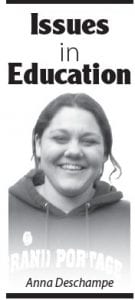At Oshki Ogimaag, a core component of our mission statement is to integrate technology throughout the curriculum. It is an unequivocal fact that young people must develop skills to utilize technology effectively and efficiently. The funding forecast for schools is constantly changing. Currently, hot topics include state budgets, federal funds sequester, and the impact on significant programs such as Federal Impact Aid. Mustering collective political clout, lobbying, and voting influences these factors. A lengthy harangue about dwindling time, money, and tools is well deserved. However, this discussion focuses on what we can control—strategic use of available resources. The purpose of this edition of Issues in Education is to provide a perspective on educational technology intended to encourage dialogue on how this rural community can most effectively use technology as a teaching tool.
Interestingly, the discussion of technology is an interwoven web that leads to other topics such as peer pressure, self-reliance, and safety. Researchers have begun to evaluate the role that social media plays in self-esteem, mental math skills are replaced with calculators, and cyber bullies follow victims everywhere. Cellular telephones are seen by many parents as a tool for safety, while students spend class time texting.
At even the most engaging professional conferences one can scan the room and see many participants engaging in the same distracting behaviors. The relationship between education and technology is the same as other relationships, it is dichotomous and developing strategies creates more questions than answers.
It is important to develop a usable definition of technology in regard to its use in the educational system. Very simply, technology is a tool enabling people to access, interpret, and convey information. In its basic form, technology is about access and communication.
As Anishinaabeg, our ancestors were masters of technology. Many cultures can claim this. Societies throughout time have had to invent and strategize in order to access necessities and communicate. As an example, resources at hand (trees) were utilized to create an innovation in technology so powerful that it influenced not only our society, but the way in which this country was developed. The birch bark canoe enabled extensive travel, thereby providing access to knowledge from other people and areas. Traveling was done by following efficient trails created on land and water. Technology creates paths to knowledge and resources.
Conversations about assessments are pervasive throughout the educational community. The processes by which adults assess children, schools assess teachers, the state assesses schools, and the federal government assesses states reiterate that everybody is held accountable to a standard. The age-old adage rings true: with great knowledge comes great power and responsibility.
Children in our society are bombarded with information. It is vital that children learn to assess information, discern fact from fiction, and develop standards for quality information. Finding information is becoming easier while utilizing information remains a challenge.
Another powerful function of technology is to collect, categorize, and interpret data. As humans, we can input numbers into a database developed by “some smart person somewhere” and we will receive an easy to read manipulation of this data. Information is conveyed through art, prose, documentation, and many other mediums. All of which have a digital interpretation.
The premise of this article promotes strategic decision-making regarding the implementation of technology, and how this technology will be used to teach academic skills. The World Wide Web provides access to a wealth of libraries, scholarly publications, and opinion pieces. To rural schools and students this is a great equalizer. The power of this knowledge is commanding, to teach discretion is essential.
In days gone by, becoming published was a great feat. Searching for primary source documentation, extensive peer review, and finding a publisher that thinks the work is worthy was the standard process. An increased forum to communicate information enables people with specialized skills that may not involve research and writing to disseminate high quality information. Public libraries and web access help to promote a society in which access to information is not available only to the privileged class.
The skill of differentiating between high and low quality sources is becoming increasingly important and must be taught to all children. Providing young people with the skills to assess will help them sort information, think critically, and develop evidence based conclusions.
Discussions of this type have been ongoing as our county embarks upon new territory thanks to the broadband project, and increased access to tools. As we move forward, it is important to discuss and declare our values. Miigwech for taking the time to read my contribution to the conversation.
Each month a representative of our local schools will offer thoughts in Issues in Education. This month’s contributor is Director Anna Deschampe of Oshki Ogimaag.



Loading Comments